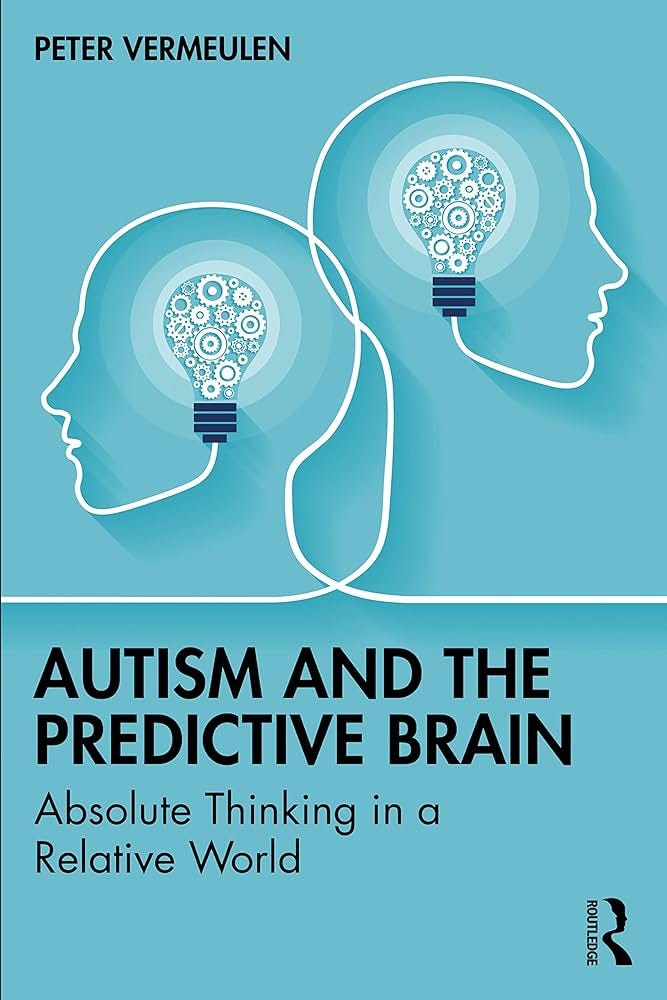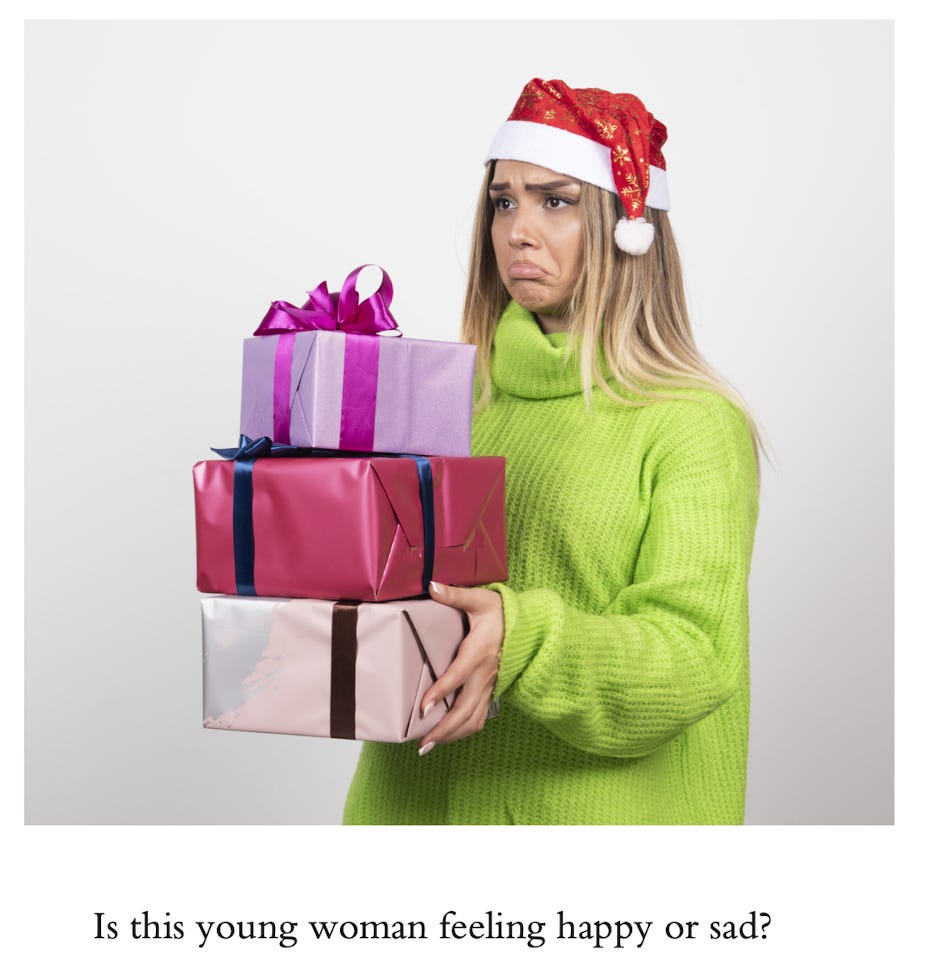A Theory of Autism and Uncertainty
Research Round-up: post-viral illness history, how medical gaslighting happens, and a little autistic joy
Welcome to this week’s grab bag of interesting readings I need to tell you about right now right now. If you enjoy my hand-curated informational dumps, consider a monthly contribution to my caffeine fund:
Last year I wrote a piece about why we scroll that touched on the theory of the predictive brain, which says that the brain doesn’t just react to the world, it’s actively creating models that predict it, top-down-like.
I wondered how this theory would apply to autistic people, who are said to process bottom-up. Well, this week I came across a book-length answer to that question:
Basically: uncertainty sucks. We all want to know what the weather is going to be like tomorrow,1 and predictions are the brain’s way of coping with the excruciating uncertainty of being conscious.
The predictive brain theory is kinda hard to grasp at first because it goes against our old input-output computer metaphors for the brain, according to Vermeulen, who prefers sports metaphors instead.
In tennis, for instance, the ball moves too fast across the court for a player to see where it’s going and then react to it; instead, they must predict where it’s going first.
As the theory goes, this is basically what our brains are doing all the time about everything — predict first, then react to errors in our predictions by updating our models of the world. These models are generalized — like, most of the time when the ball is hit from that angle, it goes over there, but sometimes there’s a fluke, and it flies off in a different direction.
Not every prediction error warrants a change to the model — sometimes a fluke is just a fluke. But Vermeulen argues that autistic people have trouble disregarding prediction errors when they’re not important — instead, everything is relevant and warrants an update to the model, which means that we can end up with super specific models that don’t generalize well (aka ‘rigid thinking’).
According to Vermeulen, where allistic people tend to rely on their predictive models when perceiving the world, autistic people rely on sensory information — we ‘first see, then believe’.
This can sometimes be a good thing — it means autistic people are often less biased,2 more logical, and more accurate in our observations3 — but it’s also overwhelming, and way, way less efficient. Sluggy as hell, if you will.
It means that we need more time to adjust, and we get stuck bouncing around in a perpetual stew of prediction errors that most people just ignore. This makes the world seem ‘far more VUCA4 – volatile, uncertain, complex and ambiguous’.
And you might say, well, the world is volatile, uncertain, complex and ambiguous, so that’s just correct! And I agree! But being confronted by this fact all day long is very stressful! The illusion of predictability shields most people from this ‘uncertainty stress’, as Vermeulen calls it.5
This is an idea about autism from someone who is not autistic, so I am sure there are critiques to be made, but I appreciate Vermeulen’s insistence that the way to help autistics with uncertainty stress is not some kind of special brain training or whatever — it’s just giving autistics more details, and where possible, more control over our sensory world:6
“It should also be remembered that offering certainty and predictability requires almost no time and no effort. You don’t need to follow an expensive training course to be able to do it. In fact, anyone can do it. And you can do it anywhere. What’s more, it benefits everyone, and not just people with autism.”
Next up, a very important history lesson, as public discourse continues to entertain the idea that Long Covid is psychosomatic:
📝 From Long Flu to Long Covid: A Brief History of Post-Viral Illness by Emily Mendenhall and Philip Finkelstein
The first widespread recognition of post-viral neurological effects was ‘influenza nervosa’ in the Victorian era (although post-viral illness had been described waaay before that by Hippocrates)
There was also a massive spike in post-viral illness across the world after the Spanish Flu of 1918, but one historian argues that nobody remembers it because it got overshadowed by World War I
Post-viral illness also appeared during polio times in 1934, when a fatiguing illness took out a bunch of medical staff in LA. Most were women, and some were TREATED WITH HYSTERECTOMIES dEAR GOD.
In the 50’s, there was the famous Royal Free outbreak in a London hospital, where Dr. Melvin Ramsay argued it was a viral issue, and the term myalgic encephalomyelitis was introduced.
But then, in the 70’s, a couple of psychiatrists shot back, arguing that it was all just a mass hysteria. This is a debate that survives to this day, such as in my hateread of 2025!
“Society cannot afford to dismiss long COVID as a niche or exaggerated condition, or ignore its striking parallels to the secondary symptoms of the Spanish flu and postviral syndromes that have emerged throughout the centuries.”
I touched briefly on the term ‘medical gaslighting’ in a recent post after finding that it’s a top concern for patients this year. But what is it, and how does it happen? Here’s a deeper dive:
📝 Medical gaslighting as a mechanism for medical trauma, Devora Shapiro & Anna Hayburn, 2024
This paper presents two case studies (both of whom have POTS!) to illustrate the traumatic effects of being dismissed by medical providers. TLDR, they argue that including medical trauma under the PTSD umbrella could improve care.
One case is overt — a patient overheard a doctor accusing them of faking — while the other case is more subtle, illustrating how a patient with a difficult-to-diagnose condition can end up with the label of ‘factitious disorder’ in their records, leading to a pattern of suspicion and dismissal in their encounters with the healthcare system
The authors argue that this is not merely personal harm, but an example of ‘testimonial injustice’ — a term from the philosopher Miranda Fricker for when a person’s credibility is viewed as suspect because of their gender, race, disability, class, etc.
“..medical gaslighting is the process of chipping away at the testimonial authority of the patient’s experience in the context of the medical encounter, as legitimately ill and in need of medical treatment.”
This can lead to medical trauma, causing ‘significant anxiety, anger, irritability, hesitation, and/or guardedness when engaging with medical providers’ and ‘may lead patients to avoid health care associated tasks or services’
“Each time a patient presents with difficult to diagnose symptoms, or they are misdiagnosed and consequently fail to respond to treatment, trust in their accounting of symptoms may decline; when a patient presents again with similar complaints, rather than suppose the medical institution has failed to identify and treat the patient’s problems, providers may instead assume the patient has failed to comply with treatment, or exaggerated their symptoms.”
“…the patient’s gaslighting is the result of more than any individual provider: it is the product of a complex network of knowledge-producing structures (medical institutions and authorities), which culminates in an institutionally supported narrative that the patient’s limited testimonial authority is unable to counter.”
📝 Experiences of Autistic Joy, Elliot Wassell, 2024
Autistic4autistic research that adds a necessary counterweight to the focus on disaster and pain that is usually found in both autism research and public discourse
Autistic people frequently discuss and write about their joy, but this can be seen as proof that they aren’t really autistic, because in the public imagination, autism = bad bad pain/tragedy: “..as Yergeau argues, autistic people are often stereotyped and essentialised and face a rhetorical double bind whereby if they enjoy being autistic then they cannot really be autistic.”
Wassell asked autistic participants about their experiences of joy, sources of which include: sensation, repetition, and complete absorption
Participants said ‘the people and place need to be right’ to experience such joy; to be in control, to feel safe, and sometimes to be alone
Participant 28: “I think one of the easiest, zero-cost things that neurotypicals can do to support autistic joy is to TRULY accept that our ‘special interests’/passions give us happiness and fulfilment to a degree that simply does not exist for neurotypicals. No matter how ‘weird’, ‘age inappropriate’, or ‘useless’ our passions might seem to them, for us, this is what makes life worth living. Autistic people shouldn’t have to hide our special interests.”
Vermeulen calls special interests ‘islands of predictability in an ocean of uncertainty.’ Currently mine is making tiny knots over and over and over again until they look like plants:
not me this summer buying the app that stormchasers use bc I learned how to read weather radar and now I like to look for hook echoes when storms roll in…
Vermeulen: “The autistic principle of ‘first see, then believe’ means that people with autism are far less inclined to make a priori assumptions about people than people without autism.”
“…this means that they are less likely to pin particular labels on people that may not necessarily be accurate. They ‘lock’ other people less in assumptions and do not fill in your behaviour in advance. Because of this, you are given a more honest chance to be who you are and to do what you want to do.”
ok this is a really interesting example, from a study where they asked allistic and autistic kids to identify emotions in images where they didn’t match the context:
Apparently most of the neurotypical kids in the study said this woman is happy, because that is the expected context of Christmas!!! whereas 7 out of 10 autistic kids accurately identified her as sad, because that is what the visual information of her facial expression is giving us.
a term that originated in the military, and is now popular in management circles. Vermeulen says this makes it ‘a perfect metaphor to explain the functioning of the human brain’… the executive in your head!!!
He doesn’t like when people slap the term ‘intolerance of uncertainty’ on autistics, because that’s kinda just an attribute of the human brain in general, so he says we experience more ‘uncertainty stress’ instead.
This footnote is for autistic design nerds, generally, but also Marta Rose, specifically: there’s a whole tangent in this book where he’s like, ‘autism-friendly’ doesn’t mean take away all the stimuli in a room (GREIGE WALLS), it means making the stimuli more controllable (dimmable lights)!!






Re: Vermeulen: it is kinda nice, though, when an allistic reiterates that it requires no time or effort to give us more details, i.e.: there's no good reason to behave like an asshole. Like, yeah!
I'm so happy about the study on autistic joy, but also it's always such a bummer that we need peer review studies to back up what we've been saying. Like yeah, we also experience joy more intensely, yeah, people tend to dislike us for no reason, yeah we have fucking feelings - what the fuck.
I gotta check out that part of the book! Thanks for the heads up :-) Also I’m writing about my new special interest right now—The sensory freedom and gender euphoria of learning to sew your own clothes!